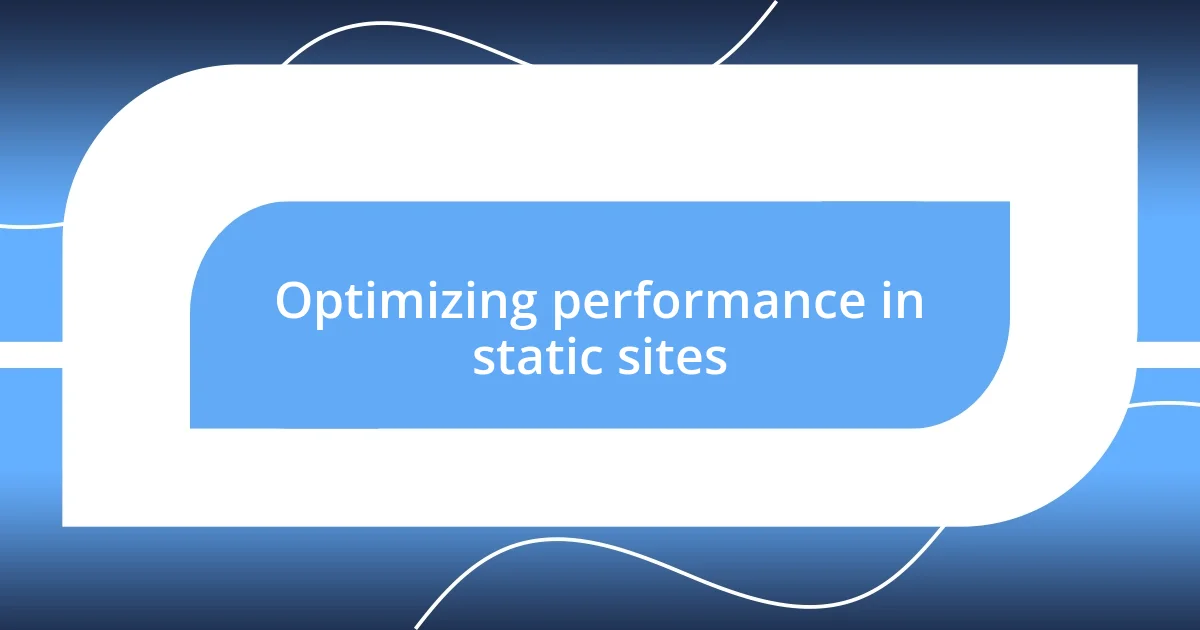Key takeaways:
- Static site generators (SSGs) transform plain text files into fast, efficient websites using pre-built HTML, offering customization and simplicity.
- Key optimization techniques for static sites include lazy loading, asset compression, and using a Content Delivery Network (CDN) to enhance performance.
- The future of SSGs is bright with the integration of headless CMS, rising collaboration in developer communities, and increased focus on performance and security.

Understanding static site generators
Static site generators (SSGs) are tools that transform plain text files into fully functional websites. I remember the first time I used one; it felt like magic as I watched my content emerge from a simple Markdown document into a beautiful web page. How incredible is it that you can manage everything with just a few lines of code?
What’s fascinating about SSGs is their ability to create fast, efficient sites because they serve pre-built HTML files. I often find myself amazed at how quickly a static site can load, especially compared to dynamic sites that require server processing. It makes you wonder, doesn’t it? Why wouldn’t everyone want the speed and simplicity SSGs offer?
These generators allow for an incredible level of customization and flexibility as well. I’ll never forget the thrill of diving into templates and tweaking them until they resonated with my personality. There’s something deeply satisfying about taking control of your website like that, don’t you think? It’s not just about building a site; it’s about crafting a unique digital space that reflects who you are.

Optimizing performance in static sites
When it comes to optimizing performance in static sites, one of the key factors is efficient resource loading. I recall a project where I implemented lazy loading for images; it was like turning on a turbo boost for my site’s performance. This simple tweak not only speeded up the initial load time but also improved the user experience significantly, especially for those on slower connections.
Another essential aspect is minimizing your asset sizes. I’ve spent time compressing CSS and JavaScript files, and let me tell you, the difference in loading times was palpable. It’s fascinating how these small changes can lead to substantial improvements, reducing file sizes often by 50% or more, and making the site feel snappier overall.
Lastly, leveraging a Content Delivery Network (CDN) can drastically enhance your site’s performance. When I started using a CDN, I was blown away by how quickly my site loaded for users around the globe. Since static sites are composed of fixed files, CDNs can cache these files and serve them to the nearest user, which is a massive advantage for accessibility.
| Optimization Technique | Description |
|---|---|
| Lazy Loading | Delays loading images until they are in the viewport, improving initial load time. |
| Asset Compression | Reduces the size of CSS and JS files, enhancing load speeds significantly. |
| Content Delivery Network (CDN) | Caches static files across distributed servers, providing faster access for users worldwide. |

Future of static site generators
The future of static site generators looks incredibly promising. With the rise of headless CMS solutions, I find myself excited about how SSGs can seamlessly integrate with these platforms, enabling developers to create dynamic experiences without sacrificing speed. It’s like having the best of both worlds, don’t you think?
As I observe current trends, I can’t help but notice an increasing focus on collaboration within developer communities. This push is fostering innovation, making it easier for newcomers to jump in and explore how to customize their sites. It reminds me of my early days, when discovering a new plugin felt like unlocking a hidden feature, and I’m curious to see how these changes will shape our approaches in the years to come.
Another exhilarating thought is the growing emphasis on performance and security. Static sites are inherently less vulnerable to typical web threats, which is a significant advantage in today’s digital landscape. As I think back to the sense of relief I felt knowing that my site had fewer vulnerabilities, it seems clear that as awareness around web security increases, so too will the appeal of static site generators.














